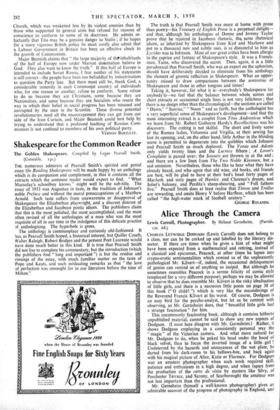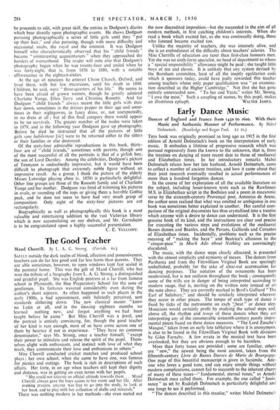Alice Through the Camera
Lewis Carroll, Photographer. By Helmut Gernsheim. (Parrish. 17s. 6c1.) CHARLES LtrrwinGE DODGSON (Lewis Carroll) does not belong to a class, nor can he be corked up and labelled by the literary dis- sector. If there are times when he gives a hint of what might have been expected from a mathematical and retiring, instead of a classical and epicurean, Peacock, at other times he lapses into crypto-erotic sentimentalities which remind us of the unpleasantly pathological Mr. Kilvert—if, indeed, the occasional delinquencies of genius can remind us of anything so insipid. But although he sometimes resembles Peacock in a serene felicity of comic style (employed for a very different purpose), perhaps we may be allowed to observe that he does resemble Mr. Kilvert in the risky idealisation of little girls, and there is a nauseous little poem on page 38 of this book ("0 child! ") which is very like the maunderings of the Reverend Francis Kilvert at his worst. Of course, Dodgson is an easy bird for the psycho-analyst, but let us be content with observing, as Mr. Gernsheim does, that "beautiful little girls had a strange fascination" for him.
This uncommonly fascinating book, although it contains hitherto unpublished material, cannot be said to show any new aspects of Dodgson. (I must here disagree with Mr. Gernsheim.) Rather, it shows Dodgson employing in a consistently personal way the " magic " of the Victorian camera. And what more natural for Mr. Dodgson to do, when he poked his head under the hood of black velvet, than to focus the inverted image of a little girl ? Undeterred by the hazards and annoyances of the wet plate, he darted from his dark-room to his bellows-box, and back again with his magical picture of Alice, Katie or Florence. For Dodgson was an amateur photographer when such work required skill, patience and enthusiasm in a high degree, and when (apart from the production of the carte de visite by masters like Silvy, of Porchester Terrace, and Sarony, of Scarborough) the amateur was not less important than the professional.
Mr. Gernsheim (himself a well-known photographer) gives an admirable account of the progress of photography in England, and he proceeds to edit, with great skill, the entries in Dodgson's diaries which bear directly upon photographic events. He shows Dodgson pursuing photographically a series of little girls until they "put up their hair," and also pursuing, though with more difficulty and occasional snubs, the royal and the eminent. It was Dodgson himself who characteristically observed that his "child friends" became "uninteresting acquaintances" when they approached the borders of womanhood. The reader will note also that Dodgson's photography began when he was twenty-four and ended when he was forty-eight, that is, from 1856 to 1880, with a notable efflorescence in the eighteen-sixties.
At the age of nineteen he entered Christ Church, Oxford, and lived there, with but few excursions, until his death in 1898. Children, he said, were "three-quarters of his life." He seems to have been afraid of grown women, though he greatly admired Charlotte Yonge, Ellen Terry and Christina Rossetti. And for Dodgson "child friends" always meant the little girls with their hair down, sometimes in the dresses proper to their age and some- times in their nightgowns, in fancy dress, or, not unexpectedly, in no dress at all ; but of this final category there would appear to be no survivals. The greater number of the nudes were taken in 1879, and in the following year Dodgson gave up photography. Before he died he instructed that all the pictures of little girls sans habilement [sic] were to be returned either to the sitters or their families or else destroyed.
Of the sixty-four admirable reproductions in this book, thirty- four are of "child friends," sometimes with parents, though one of the most successful of all the portraits is that of a girlish boy, the son of Lord Darnley. Among the celebrities, Dodgson's picture of Tennyson is undoubtedly impressive, but it would have been difficult to photograph that extremely noble figure without, an impressive result. As a group, I think the picture of the elderly Misses Lutwidge playing chess (c. 1858) is particularly delightful. Other fine groups are those of the Rossetti family and of Charlotte Yonge and her mother. Dodgson was fond of trimming his pictures in ovals, or rounding off the tops or giving them a horrible Gothic peak, and he does not seem to have had very much grasp of composition. Only eight of the sixty-four pictures are cut rectangularly. Biographically as well as photographically this book is a most valuable and entertaining addition to the vast Victorian library which is now accumulating on our shelves, and Mr. Gernsheim is to be congratulated upon a highly successful presentation. C. E. VULLIAMY.



































 Previous page
Previous page